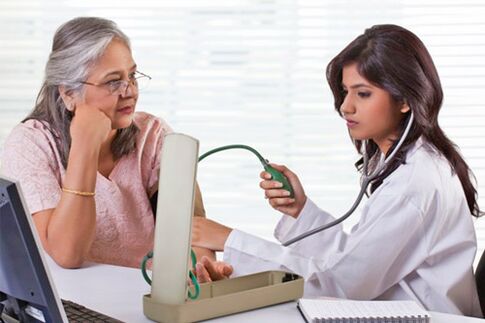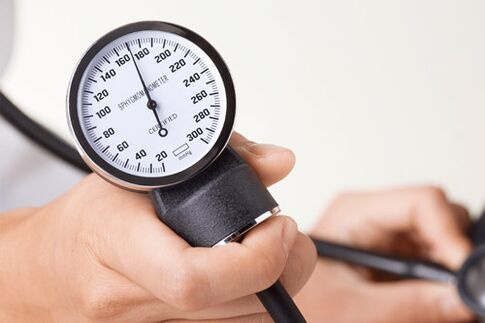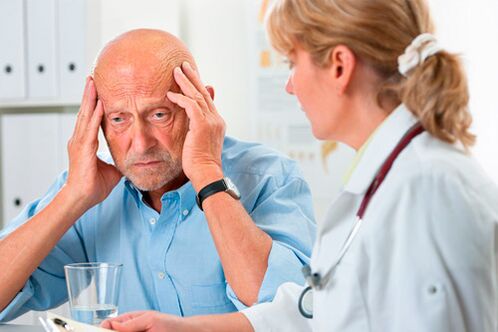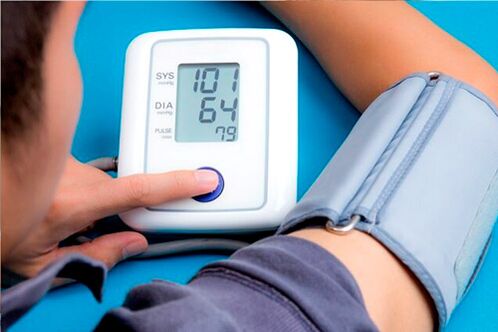Age-related features of different periods of a person's life, external and internal causes, changes in hormone levels, bad habits, and psycho-emotional factors can affect changes in blood pressure and lead to its increase. People do not always go to the doctor on time, so hypertension becomes permanent. The article will tell about the symptoms of hypertension, as well as its differences with hypotension.
First manifestations

High blood pressure is characterized by morphological changes in blood vessels that affect a person's general well-being. To find out if a person has hypertension and what are the symptoms of this pathology, you need to know the simplest methods of self-diagnosis that will help you respond properly to a jump in performance and prevent complications.
Hypertension is one of the most common diseases. Hypertension occurs in every third person and is characterized by high mortality in severe stages. Only a comprehensive treatment that combines medication and maintaining a healthy lifestyle can be successful.
Hypertension is characterized by a gradual, prolonged, slow course and is initially characterized by the absence of severe symptoms. In high blood pressure, the presence of the disease can be indicated by recurrent symptoms, which include:
- pain in the occipital or temporal area;
- dizziness;
- hearing loss, ringing in the ears;
- blurred vision;
- tachycardia and chest pain;
- nausea and throat reflex;
- shortness of breath;
- anxiety;
- irritability;
- sweating or chills;
- recurrent nosebleeds.
Having at least one of the above symptoms of hypertension, which may be the first, is a reason to visit a family doctor or therapist for diagnostic and preventive purposes, as the disease in advanced, untreated condition can lead to such terrible complications as heart attack. myocardial infarction and ischemic stroke.
Characteristics of the symptoms
Arterial hypertension always passes with a headache in the back of the head or temples, which at the beginning of the pathology is well stopped by analgesic drugs. Its appearance is associated with a change in the lumen of cerebral vessels in the direction of narrowing. People who experience high blood pressure headaches describe it as dull or like spasms in the back of the head and sharp, piercing, throbbing in the temporal area.
Tinnitus and hearing loss in hypertension can be caused by a malfunction of the vessels of the hearing aid.
Important! Sudden onset of headache is a direct indication for measuring blood pressure.
Deterioration of vision in hypertension in the form of doubling, blinking dots (flies) in front of the eyes is associated with a lack of blood supply to the retina and impaired optic nerve function.
Nausea and throat reflex occur as a reaction to the onset of headache and dizziness, and the manifestation of frequent palpitations and pain behind the sternum is caused by a violation of the vessels of the pulmonary circulation. The feeling of shortness of breath (shortness of breath) characterizes high blood pressure and is more common in obese patients of all ages.
Frequent symptoms of high blood pressure can cause a state of hypertension. And then hyperemia of the facial skin, anxiety, heart pain will join the above signs of pathology. This condition will not go away on its own and will require urgent therapy.
Important! Periodic symptoms of high blood pressure will prompt the patient to consult a doctor and start treatment. The asymptomatic course of the disease steals valuable time from a person.
Tonometer indicators
To find out if there is an increase in pressure, it is necessary to periodically measure the indicators with a tonometer in different conditions (well-being, bad), as well as to know their norms.
The standard values are considered to be 120/80 mm Hg. Art. A range of 10 units of these numbers is not a deviation. Signs of elevation above 140/90 mm Hg. Art. , in combination with headache, nausea, heart pain are considered symptoms of hypertension.
Important! The pressure in a person is always individual, depending on the body and external causes. "Working" tone - these are the numbers of blood pressure at which the patient feels good. Patients with hypertension know their normal values and control them by taking timely antihypertensive drugs selected by the attending physician.
Characteristics of the degrees of pathology
The signs of high blood pressure directly depend on the degree of height of the indicators, of which there are 3 in hypertension. They can be presented in the form of tables:
> zxtable border = "1" cellpadding = "0" >
The clinical picture of hypertension in the early stages may be mild. For a long time a person may not even be aware of the increased pressure and the processes developing in the vessels. The early and first signs of hypertension are irritability for no apparent reason and increased fatigue.
Symptoms of high blood pressure in hypertension 2 and 3 degrees with systolic readings above 160 mm. lead to a hypertensive crisis, which is characterized by severe headache of various kinds, nausea, vomiting, blurred vision (fog, shroud) or blinking of small dots, as well as: trembling limbs, rapid pulse, feeling of lack ofair, heart pain, arrhythmia, loss of consciousness.
What is hypertension - all patients with hypertension know. It is useful to know how you can help yourself or a loved one before the ambulance arrives when an emergency first arises:
- Place 1 tablet of validol or nitroglycerin under the tongue.
- Arrange for air access, unbutton tight clothing, and give the patient a raised position in bed (lifting pillows).
- Apply mustard patches to the calf muscles.
- Give inside 30 drops (1 tablespoon) alcoholic solution of valerian, motherwort.
- Take any analgesic for headaches and apply menthol oil to the whiskey, forehead, neck and behind the ears.
- You can soak your feet in hot water for 15 minutes.
In addition, doctors recommend doing a simple exercise to restore breathing. To do this, it is recommended to take a deep breath, hold your breath and then exhale very slowly. This should be done 3 to 5 times. The position of the body in this case should be lying down.
Important! With untimely care of a patient with a hypertensive crisis, he may develop a stroke or myocardial infarction. As Grade 2 and 3 cannot be cured, the patient must keep the pressure rise under constant control.
Age features
Increased blood pressure in people over 50 is often associated with initial problems with the functioning of the heart and blood vessels, atherosclerosis, anemia, hyperthyroidism and impaired renal function. There may be shortness of breath, severe swelling of the legs, cardiac arrhythmia. Compared to men, women get sick more often.
The symptoms of high blood pressure are always due to age-related changes in the vessels, which leads to a loss of their elasticity. In addition to the typical clinical features of high blood pressure, it is possible to add intermittent claudication, frequent seizures, dizziness when changing body position, noise in the head and a symptom of compressive pain behind the sternum. There is also general malaise, reduced ability to work and weakness.
Because the increase in the rate can occur in people of different ages, the symptoms of hypertension in adolescents can appear from 12 years of age (during puberty) and last up to 17 years. This is due to the restructuring of the body and changes in hormonal metabolism. Characteristic signs that the teenager has high blood pressure are increased sweating, strong pulse attacks, tinnitus, dizziness, headache at any time of the day, insomnia, hot flashes on the skin of the face, discomfort in the epigastric region.
Important! To make sure that in this particular case there is a possible vascular pathology, it is necessary to measure the pressure in a person several times in a row, preferably every 15 minutes. These indicators should be recorded and be sure to report them to your doctor to prescribe adequate treatment. Which drugs to take - the doctor will decide.

If you find several symptoms accompanied by an increase in blood pressure, you should consult a doctor, be examined and determine the true cause of such pathology: neoplasms, kidney, endocrine, vascular diseases. The therapist, neurologist and family doctor will prescribe appropriate treatment based on diagnostic data, functional characteristics of the body, age group, comorbidities and susceptibility to allergies.
In hypertension, adrenoblockers, diuretics, ACE inhibitors, slow calcium channel blockers are prescribed.
Apply physiotherapy - electrosleep; magnetic therapy; UHF therapy; infrared laser therapy as well as traditional medicine. Patients with hypertension are advised to follow a diet and consume enough fruits and vegetables.
Important! Preventive measures to prevent vascular pathology and the development of hypertension include timely visits to medical examinations, normalization of work and rest, moderation in diet, combating overweight, prevention of stress, use of sufficient water, vegetables, fruits andelimination of nicotine and alcohol dependence (if any).
Differences between high and low pressure
Along with the signs of hypertension, in which the frequency may increase, there are manifestations of low blood pressure called hypotension.
The periodic decrease in pressure is characterized by indicators below 101/66 mm Hg. Art. It all depends on the age group, so the numbers may vary.
Despite the fact that the presence of unbearable paroxysmal headache occurs in both hypotension and hypertension, with a decrease in pressure will appear the following symptoms that distinguish high from low:

- Poor health and weakness. From the morning the patient feels weak and unwell.
- Cold limbs. Hands and feet are constantly cold.
- Tinnitus (periodic presence).
- Unpleasant sensations in the heart, tachycardia. Each patient has their own feelings.
- Dizziness and frequent darkening (sometimes double vision) in the eyes. Such symptoms are characteristic not only in the morning but also during the day.
- Drowsiness during the day, sleep disturbance at night. During the day, patients feel the need to sleep all the time. The peak of activity begins in the evening. The night passes restlessly, sleep is shallow.
- Digestive problems. Patients with hypotension often have gastritis, liver problems, constipation, dyspepsia and dysbacteriosis.
The above characteristic symptoms are most common in young people, most of whom are women. The reason for lowering blood pressure is stress, lack of sleep, poor lifestyle, lack of vitamins, use of strict diets, hormonal disorders, severe physical and mental stress, the presence of certain somatic diseases (endocrine, cervical osteochondrosis, liver, kidneys, VVD, sedentary lifestyle). Prolonged depression can be a major cause of low blood pressure.
The first "bells" for the onset of hypotension appear when in the morning a person gets heavy from bed, feels overwhelmed, irritated and does not sleep enough. After a while (each is purely individual) a headache appears, which may not disappear until noon.
The most common symptoms of hypertension here are nausea, vomiting, meteorological dependence and fainting, long asymptomatic course. You can raise low blood pressure by taking special medications, diet therapy, herbal remedies and maintaining a healthy lifestyle.
therapy
Drugs that increase blood pressure include tinctures of Eleutherococcus or ginseng, special drugs. Caffeine has the same effect.
Herbal treatment includes taking decoctions and infusions of herbs from plants such as St. John's wort, lemongrass, ginseng, immortelle, tartar, ginger.
In patients with hypotension, it is acceptable to take small doses of alcohol. A glass of red wine or 25 g of cognac for a week will benefit the body: it will dilate blood vessels and improve blood circulation. A cup of coffee in the morning will bring good mood.
Patients with hypotension should get enough sleep to feel alert (more than 8 hours a day), get enough exercise, eat a balanced diet and also engage in moderate sports (morning exercises, swimming, aerobics, yoga, outdoor games), take a shower with a contrast shower, alternating them with massage.
Important! Untreated hypotension after the age of 40 can turn into hypertension.
Everyone is advised to carefully monitor their blood pressure levels. It is necessary to use the tonometer in a relaxed state, in good and bad health, after sleep and before night. It is desirable to record all indicators, to compare and determine "your" pressure, which marks the best performance and vital activity.
If the increased numbers persist for a long time, you should definitely consult a doctor to prevent fatal complications in the future. Be healthy!



























